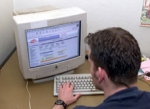24 November 2006
Fake relics sold on eBay 'funding terrorism'
 (dailymail.co.uk) Forged archaeological artefacts traded on internet auction sites such as eBay are helping to fund international...
(dailymail.co.uk) Forged archaeological artefacts traded on internet auction sites such as eBay are helping to fund international...
Forged archaeological artefacts traded on internet auction sites such as eBay are helping to fund international terrorism, it was disclosed today.
The faked historical relics, purporting to be genuine, Middle Eastern artefacts dating from as far back as 2000 BC, are being sold to innocent collectors and tourists for up to £2,000 each.
Police believe the profits are flowing back into criminal networks in the Middle East and that some is helping to fund insurgency in places like Iraq.
Some of the seized artefacts were on display at an exhibition of fake and forged works of art at the Victoria and Albert Museum in London today.
The exhibition is being held by the Metropolitan Police's specialist Arts and Antiques unit to raise awareness of the increasingly sophisticated fraud, estimated to worth up to £200 million a year in Britain alone.
Detective Constable Ian Lawson said of the artefacts: "We know for a fact that there is a terrorism link. Archaeological stuff is being exported by the tonne load from Middle Eastern countries. If the money goes back into criminality, some will inevitably end up in the hands of terrorists."
The event also showcased the work of master forger Robert Thwaites.
Thwaites, 54, duped respected gallery owner and TV art specialist Rupert Maas into parting with £20,000 for a worthless painting he claimed was by fairyland painter John Anster Fitzgerald (1823-1906).
The forgery, entitled The Miser, was so convincing that the dealer was able to sell it on for a 300 per cent mark-up.
Thwaites also tricked gallery proprietor Dr Christopher Beetles out of more than £100,000 with another creation called Going To The Masked Ball, also said to be by the Victorian artist. He was jailed for two years at Middlesex Guildhall Crown Court earlier this year.
The paintings were displayed today as an example of the lengths to which forgers will go to pass off their work as genuine.
It was only when Thwaites attempted to sell a third painting entitled Poppy with Imps and Fairies and Foliage with his brother Brian Thwaites, 50, that a would-be client became suspicious and the pair were arrested.
At the exhibition today, a series of scanned-in preliminary drawings of the painting, that police officers found on a laptop, were on display to demonstrate how a forgery is created.
He began with a photograph of a poppy from his garden and then worked up through a series of pencil tracings and then paintings to produce the finished work on the style of Fitzgerald.
Julian Radcliffe, chairman of the Art Loss Register, the exhibition's sponsors, said that up to £200 million worth of fakes and forgeries were traded in Britain every year.
A small proportion of these were bought and sold legitimately, but the majority were traded fraudulently, he said.
In Britain, police do not have the power to destroy fakes and forgeries as they do in other European countries.
"Many things that were fakes 500 years ago are now considered works of art in their own right," Mr Radcliffe explained.
However, he said it would be a "very good idea" to give police the discretion to destroy or confiscate forgeries in some cases, to remove them from the market.
The Met's special one-off exhibition has been designed to raise awareness of art fraud, which is becoming increasingly sophisticated and popular with gangs.
If they were genuine, the artworks on display would be worth around £10 million.
Detectives are hoping the exhibition will help demonstrate to industry figures the extreme lengths to which forgers are now going in order to fool the experts.
Police say art forgery is used increasingly by organised criminal gangs as an easy way of making money. They are even using faked copies of priceless stolen works in drug deals, duping other criminals.
Detective Sergeant Vernon Rapley, head of the Arts and Antiques Unit, said: "This is a unique opportunity for the Met's unit to bring together key players in the arts and antiques industry to see the types of crime being committed.
"The greatest weapon we have in combating this type of crime is the knowledge and know-how of our partners and as quickly as criminals are adapting their techniques we are also developing ways to eliminate this type of crime."
Scotland Yard is considering opening the exhibition publicly next year.
07:07 Posted in UNITED STATES | Permalink | Comments (0) | ![]() Facebook |
Facebook |



















The comments are closed.